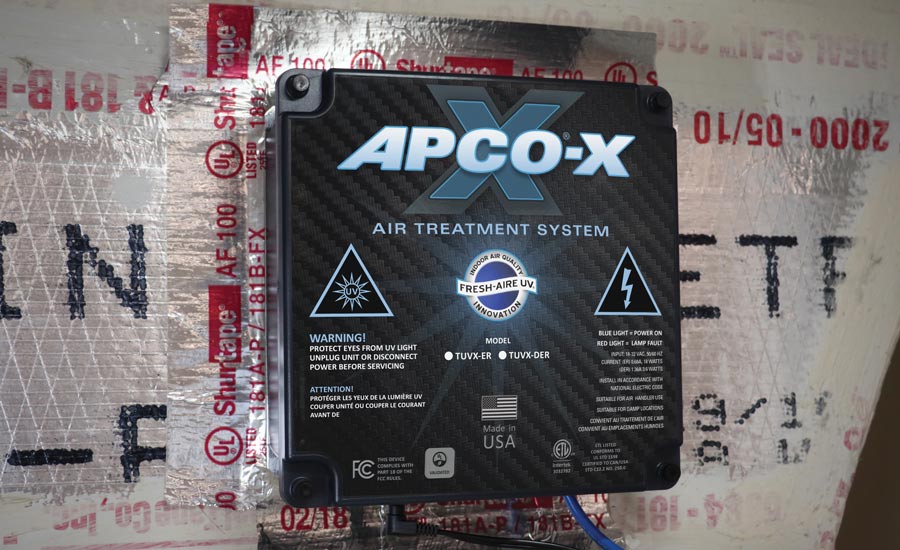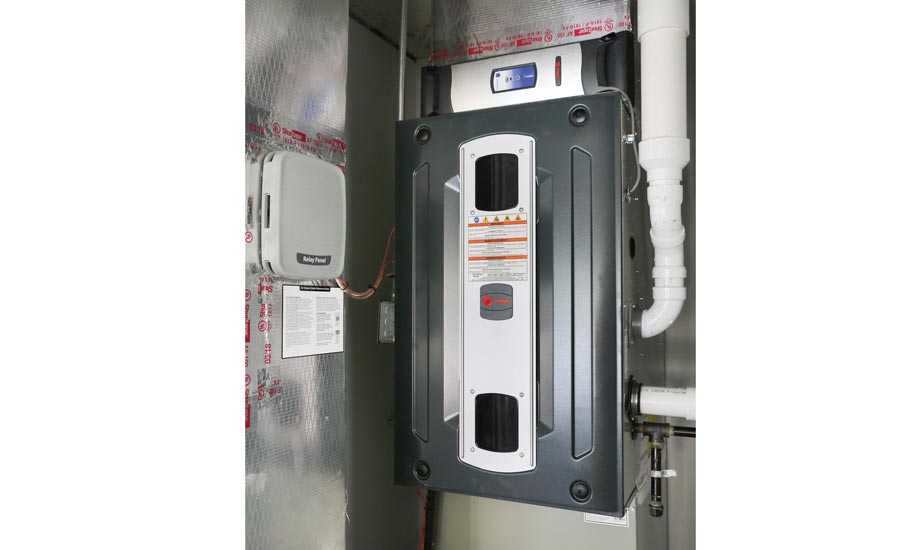Indoor air quality has been top of mind in the HVAC industry, and contractors should be experts in the IAQ technology that the market has to offer. The successful contractor will know how to utilize these products to solve IAQ issues for customers, as well as how to describe the benefits of IAQ solutions in a way that customers can understand, leading to purchasing decisions.
Solutions for Homeowners
Darcy Lee, senior product manager for Trane Residential, said that her company groups indoor air quality into three main pillars: contain, clean, and dilute and exhaust. Products that focus on containing are centered on managing temperature and humidity to ensure that a homeowner is comfortable. Cleaning products work to remove impure particulates from the air, and dilute and exhaust solutions work to remove stale air from a home and replace it with fresh air.

MANAGEABLE MAINTENANCE: Contractors should look for UV-C technologies that are easy to service and maintain in order to create a win-win for themselves and their customers. Courtesy of Fresh-Aire UV
Aaron Engel, vice president of business development for Fresh-Aire UV, explained that there is a wide range of IAQ products available.
“Filtration, humidification, and UV technologies have all been adopted to help improve the air we breathe,” he said. “UV-C systems have been widely used in HVAC for more than 20 years and have garnered significant attention in recent months for its ability to address airborne viruses. An ideal IAQ strategy would be using a good quality MERV 8-11 filter in combination with a UV-C system.”
Engel explained that the filter captures the airstream’s larger particles, while the UV-based system addresses the contaminants that are so small that they would otherwise pass through the filter.
Nick Agopian, vice president, sales and marketing, RenewAire, said that homeowners can choose to preserve air quality through exhaust-only ventilation, filtration, or balanced ventilation using energy recovery. He said that balanced ventilation is the best of these three options, as it offers a positive displacement of stale contaminated indoor air with fresh clean outdoor air.
“The energy recovery converts homes into high performing structures with energy-efficiency and increased airflow capacity at a low cost,” he said. He cautioned that exhaust-only ventilation can place a structure under negative pressure, causing air to leak through wall cavities. In addition to this, certain types of filtration, like ozone-producing technologies or technologies generating ROS’s (Reactive Oxygenated Species), can clean the air but may cause harmful byproducts.
How To Sell IAQ Products
“According to the EPA, the average homeowner spends 93% of their life indoors,” Lee said. “The issue is that indoor air quality is not something that you see. Typically, what you observe are the effects of poor indoor air quality.” The symptoms of bad IAQ include fatigue, respiratory illness, mold, and others, but people do not often realize that these issues trace back to inferior air quality. Some of the most harmful substances present in the air are five to seven times smaller than a human hair, remaining invisible to the naked eye.
Lee also explained that contractors must connect the dots for homeowners, explaining that some of the problems a resident is facing could find their causes in suboptimal IAQ. Various products are available to help with this: filters for purifying the air, variable speed systems that can control temperature and humidity, as well as humidifiers and dehumifiers. She said that the Trane Clean Effects Air Cleaner is designed for preserving IAQ in a space.
Regarding the way contractors serve customers, Lee said that the important issue is installing the correct solution that fixes the problem.
“Every unit and every system should be properly maintained, and we definitely recommend having a service contract to make sure that all the components are maintained,” she said.
Engel said that contractors should sell IAQ products backed by substantiated data and research they can show their customers.
“IAQ issues and their solutions are often subjective and difficult to quantify,” he said. “Look for products that are UL-validated for zero-ozone generation, because ozone or airborne oxidizers have been proven in ASHRAE position papers to pose more occupant health risks than benefits.” He explained that the ideal strategy is a system that addresses the air in real time as it passes through the HVAC unit. One such system is a UV-C-based system that is located over the evaporator coil.
“They work in combination with activated carbon,” he said. “Together, they have the ability to disinfect the HVAC equipment that’s prone to mold and biofilm growth, and remove odors and volatile organic compounds (VOC) in the airstream.” As an HVAC system circulates air, biofilm can rob equipment efficiency and reintroduce microbial contaminants and odors back into the living area.
In addition to this, Engel said that contractors should consider an IAQ technology’s maintenance. If the system requires a significant amount of upkeep or does not perform up to manufacturer’s recommendations, contractors could lose sales and suffer the consequences in their relationship with customers.
“Contractors should look for technologies that are manageable to service and maintain,” he said. “UV-C systems that offer a lifetime carbon matrix, install in minutes, and only require a UV lamp replacement from one to three years (depending on make and model) are a win/win for the contractor and the homeowner.”
Energy recovery ventilator (ERV) systems, which Agopian recommends, use a standalone plug-in unit that offers the positive displacement of air and MERV-13 filtration. He explained that some systems even offer a boost mode, which can be used to temporarily increase airflow under adverse conditions, like when odors are being produced during cooking.
With the pandemic on top of everyone’s mind, now is an excellent time for contractors to not only sell air purification technologies but an entire IAQ suite. ERVs are also a sustainable approach to maintaining a home’s IAQ, as Agopian said they only require a 2-inch-thick filter that needs replacement the same time as the general furnace media filter. The systems also require annual vacuuming of the energy recovery core.
“Because we’ve now been able to have a conversation about viruses, we can talk about all indoor air quality,” said Lee. “There’s so much more to indoor air quality once you start talking about ventilation and humidity control.”



Report Abusive Comment